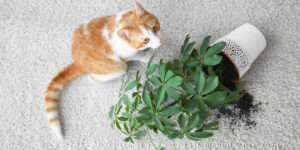
Are Snake Plants Toxic to Dogs? A Comprehensive Guide
Snake plants, also known as Sansevieria trifasciata, are popular houseplants known for their air-purifying properties and low-maintenance care. However, they pose a risk to canine companions due to their toxic nature. This article will delve into the details of snake plant toxicity, its effects on dogs, and provide guidance on how to keep your pets safe.
What Makes Snake Plants Toxic to Dogs?
Snake plants contain a group of compounds called saponins, which are naturally occurring and serve as a defense mechanism against insects, bacteria, and fungi. These saponins are toxic to dogs and can cause a range of symptoms if ingested.
Symptoms of Snake Plant Poisoning in Dogs
If a dog ingests a snake plant, it may exhibit several symptoms due to the toxic effects of saponins:
- Gastrointestinal Upset:
- Vomiting: One of the most common symptoms is vomiting, which can occur shortly after ingestion.
- Diarrhea: Diarrhea is another frequent symptom, often accompanied by bloody stools.
- Nausea: Dogs may show signs of nausea, such as drooling or lack of appetite.
- Other Symptoms:
- Hypersalivation: Increased salivation can be observed.
- Dilated Pupils: In some cases, the pupils may become dilated.
- Gastrointestinal Distress: This can lead to severe inflammation of the intestines and, in rare cases, rupture of red blood cells.
Severity of Poisoning
The severity of the symptoms depends on the amount of the plant consumed. While deaths from snake plant poisoning are rare, it is crucial to seek veterinary care promptly if you suspect your dog has ingested any part of the plant.
How to Keep Your Dog Safe
To ensure your dog’s safety around snake plants, follow these guidelines:
- Placement:
- Out of Reach: Place the snake plant in a location that is out of your dog’s reach, such as a high shelf or a room where your dog is not allowed.
- Supervision:
- Monitor Your Dog: Keep an eye on your dog when it is near the plant to prevent any accidental ingestion.
- Alternative Plants:
- Pet-Friendly Plants: Consider replacing snake plants with pet-friendly alternatives, such as Kentia palms or baby rubber plants.
What to Do If Your Dog Ingests a Snake Plant
If you suspect your dog has ingested a snake plant, it is essential to act quickly:
- Assess the Situation:
- Amount Consumed: Determine how much of the plant your dog has ingested. Even small amounts can cause symptoms, but larger quantities increase the severity.
- Seek Veterinary Care:
- Immediate Action: Contact your veterinarian or the ASPCA Animal Poison Control Center (APCC) at (888) 426-4435 for advice. If your dog is not vomiting, the veterinarian may induce vomiting to expel the plant material from the stomach.
- Treatment:
- Fluid Therapy: Your veterinarian may administer fluid therapy with electrolytes to correct dehydration and flush the toxin from the body.
- Medications: Antiemetic medications may be given to control vomiting, and other therapies may be administered to protect the stomach and intestine lining.
Table: Key Details of Snake Plant Toxicity to Dogs
| Component | Details |
|---|---|
| Toxic Compounds | Saponins |
| Symptoms | Vomiting, diarrhea, nausea, hypersalivation, dilated pupils |
| Severity | Mild to moderate; rare cases of severe gastrointestinal distress |
| Prevention | Place out of reach, monitor your dog, consider pet-friendly alternatives |
| Action if Ingested | Assess amount consumed, seek veterinary care, induce vomiting if necessary |
| Treatment | Fluid therapy, antiemetic medications, protective stomach and intestine lining therapies |
| Source | [Snake Plant |
FAQ Section
Q: Are snake plants toxic to dogs?
A: Yes, snake plants are toxic to dogs due to the presence of saponins, which can cause gastrointestinal upset and other symptoms if ingested.
Q: What symptoms can dogs exhibit if they ingest a snake plant?
A: Symptoms include vomiting, diarrhea, nausea, hypersalivation, and dilated pupils. In severe cases, it can lead to rupture of red blood cells.
Q: How can I keep my dog safe around snake plants?
A: Place the snake plant out of your dog’s reach, monitor your dog when it is near the plant, and consider replacing it with pet-friendly plants.
Q: What should I do if my dog ingests a snake plant?
A: Assess the amount consumed, seek immediate veterinary care, and follow advice from the ASPCA Animal Poison Control Center if necessary.
Q: Are all parts of the snake plant toxic to dogs?
A: Yes, all parts of the snake plant contain saponins and are toxic to dogs.
Q: Can snake plant poisoning be fatal to dogs?
A: While rare, severe cases of snake plant poisoning can be serious. Prompt veterinary care is crucial to ensure a positive outcome.
Conclusion
Snake plants, while beneficial for indoor air quality, pose a significant risk to dogs due to their toxic nature. Understanding the symptoms, prevention methods, and necessary actions if ingestion occurs is crucial for pet owners. By keeping snake plants out of reach and being prepared for any potential ingestion, you can ensure your dog’s safety and well-being.This comprehensive guide aims to provide readers with a detailed understanding of the toxicity of snake plants to dogs, ensuring they can take necessary precautions to protect their pets. Always prioritize your pet’s safety by choosing pet-friendly plants and being vigilant about potential hazards in your home.


